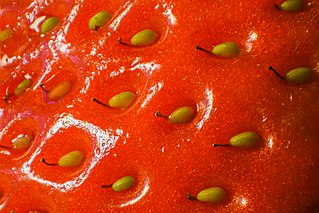
An achene, also sometimes called akene and occasionally achenium or achenocarp, is a type of simple dry fruit produced by many species of flowering plants. Achenes are monocarpellate and indehiscent. Achenes contain a single seed that nearly fills the pericarp, but does not adhere to it. In many species, what is called the "seed" is an achene, a fruit containing the seed. The seed-like appearance is owed to the hardening of the fruit wall (pericarp), which encloses the solitary seed so closely as to seem like a seed coat.

The gray fox, or grey fox, is an omnivorous mammal of the family Canidae, widespread throughout North America and Central America. This species and its only congener, the diminutive island fox of the California Channel Islands, are the only living members of the genus Urocyon, which is considered to be genetically basal to all other living canids. Its species name cinereoargenteus means "ashen silver".

Crepis, commonly known in some parts of the world as hawksbeard or hawk's-beard, is a genus of annual and perennial flowering plants of the family Asteraceae superficially resembling the dandelion, the most conspicuous difference being that Crepis usually has branching scapes with multiple heads. The genus name Crepis derives from the Greek krepis, meaning "slipper" or "sandal", possibly in reference to the shape of the fruit.

Taraxacum officinale, the dandelion or commondandelion, is a flowering herbaceous perennial plant of the dandelion genus in the family Asteraceae. The common dandelion is well known for its yellow flower heads that turn into round balls of many silver-tufted fruits that disperse in the wind. These balls are usually called "clocks" in both British and American English. The name "blowball" is also used.
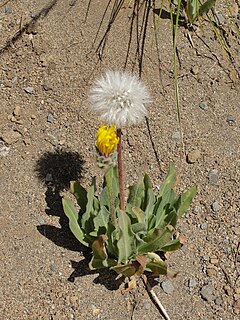
Agoseris is a small genus of annual or perennial herbs in the family Asteraceae described as a genus in 1817.

Malacothrix is a genus of plants in the tribe Cichorieae within the family Asteraceae. They are known generally as desert dandelions or desertdandelions. Most are native to western North America although a few have been introduced to South America. Several are found only on offshore islands in the Pacific.

Glyptopleura is a genus of North American plants in the family Asteraceae. The common names for this plant include carveseed, holy dandelion, keysia, and crustleaf.

Glyptopleura marginata is a species of North American plants in the family Asteraceae. The common names for this plant include carveseed, keysia, and crustleaf.
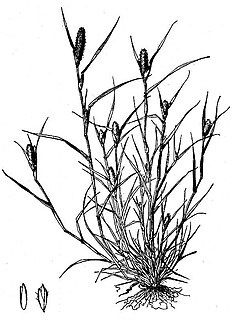
Crypsis is an African and Eurasian plant in the grass family sometimes referred to as pricklegrass.

The Cichorieae are a tribe in the plant family Asteraceae that includes 93 genera, more than 1,600 sexually reproductive species and more than 7,000 apomictic species. They are found primarily in temperate regions of the Eastern Hemisphere. Cichorieae all have milky latex and flowerheads that only contain one type of floret. The genera Gundelia and Warionia only have disk florets, while all other genera only have ligulate florets. The genera that contain most species are Taraxacum with about 1,600 apomictic species, Hieracium with about 770 sexually reproducing and 5,200 apomictic species, and Pilosella with 110 sexually reproducing and 700 apomictic species. Well-known members include lettuce, chicory, dandelion, and salsify.

Hypochaeris glabra is a species of flowering plant in the dandelion tribe within the daisy family known by the common name smooth cat's ear. It is native to Europe, North Africa, and the Middle East but it can be found on other continents where it is an introduced species and a widespread weed. It has become widespread in Africa, southern and southeastern Asia, Australia, and parts of the Americas.

Agoseris aurantiaca is a species of plant in the family Asteraceae, commonly called orange agoseris or mountain dandelion. It is widespread and common in western North America from Alaska and the Northwest Territories in Canada southward to California, Arizona, and New Mexico, and eastward as far as the Rocky Mountains and the Black Hills. There are also isolated populations in the Chic-Choc Mountains on the Gaspe Peninsula and in the Otish Mountains of central Quebec.

Agoseris glauca is a North American species of flowering plants in the family Asteraceae known by the common names false dandelion, pale agoseris, prairie agoseris, and short-beaked agoseris.
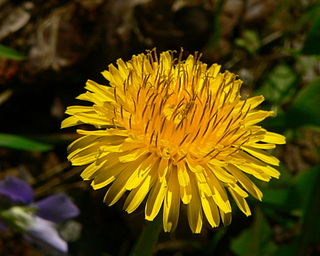
Taraxacum is a large genus of flowering plants in the family Asteraceae, which consists of species commonly known as dandelions. The scientific and hobby study of the genus is known as taraxacology. The genus is native to Eurasia and North America, but the two most commonplace species worldwide, T. officinale and T. erythrospermum, were introduced into North America from Europe and now propagate as wildflowers. Both species are edible in their entirety. The common name dandelion is also given to specific members of the genus.
Dorcatoma setulosa is a species of beetle in the family Ptinidae.
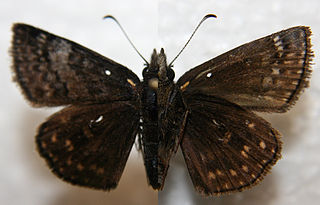
Erynnis brizo, the sleepy duskywing or banded oak duskywing, is a species of Hesperiidae butterfly that occurs throughout North America and is commonly confused with E. juvenalis and E. lucilius. The species is listed as threatened in Connecticut and Maine.
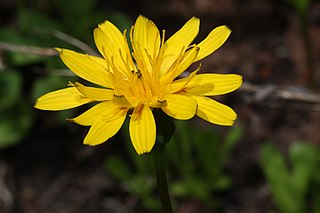
Nothocalais is a genus of North American flowering plants in the tribe Cichorieae within the family Asteraceae. There are known generally as false dandelions or false agoseris.
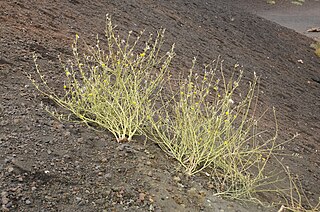
Chondrilla is a genus of flowering plants in the family Asteraceae. They are native to Eurasia, and certain taxa are known as introduced species outside their native range. The best known of these is rush skeletonweed, a noxious weed established in Africa, Australia, and the Americas.
Hieracium bolanderi or Bolander's hawkweed is a North American plant species in the dandelion tribe within the sunflower family. It is found primarily in the mountains of western Oregon and northern California in the United States, although there are reports of the species farther south in the San Bernardino Mountains in southern California and also in Baja California in Mexico.
Hieracium nudicaule is a North American plant species in the dandelion tribe within the sunflower family. It grows only in the western United States, primarily in California and Oregon, though with a few populations in Washington and northern Idaho.















